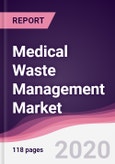Medical waste is a solid or liquid waste generated during the diagnosis, treatment, and immunization of humans or animals from health facilities (such as hospitals, pharmaceuticals, nursing homes, medical offices, and others). Various treatment options exist for the management of medical waste. Although incineration is the preferred option, there are several environmental pollution issues. The market is estimated to grow at a CAGR of 5.3% during the forecast period 2018–2025. The Asia-Pacific Medical Waste Management market is forecast to grow at the highest CAGR of 6.5%, which can be mainly attributed to the not-so-stringent government regulations in the APAC countries, such as Japan, China. and India.
Medical Waste Management Market Outlook
Management of the medical waste depends upon the effective waste segregation. If segregation is not proper, then there is always a chance of small quantity of hazardous waste getting mixed with large quantity of medical waste, making the complete volume into hazardous waste. There are various types of waste in the Medical Waste Management market such as sharps, chemical waste, pathological waste, industrial waste, and other waste types. Companies are coming up with innovative technologies to manage medical waste, which pose low threat to mankind, flora, and fauna. The Medical Waste Management market is segmented on the basis of waste type, treatment technology, services, treatment site, nature of waste, and waste generator. The market has been analyzed on the basis of its geographic region comprising of North America, South America, Europe, Asia-Pacific, and Rest of the World.
Medical Waste Management Market Growth Drivers
In order to ensure safety from hazardous waste, governments in different countries regulate proper methods of handling and disposal. In the U.S., medical waste is regulated under the Resource Conservation and Recovery Act (RCRA) and the European Commission in Europe by the Environmental Protection Agency. This regulation leads to the efficient management of health facilities' medical waste. The demand for the use of environmental-friendly and cost-effective non-incineration technologies is increasing as serious problems, such as the emission of toxins into the air using incineration technology, are considered to be the primary method for the treatment of medical waste. This innovative technology for medical waste is driving the overall market growth.
Medical Waste Management Market Challenges
In the U.S. and European countries, due to strict regulations, most medical waste management service providers require permits, approvals, certificates, and other types of government permits from all jurisdictions in which they operate. Regulated waste disposal costs 10 times as much as unregulated waste disposal. As the quantity of medical waste produced increases, reducing regulated medical waste from health facilities is a challenge.
Medical Waste Management Market Research Scope
The base year of the study is 2017, with forecast done up to 2025. The study presents a thorough analysis of the competitive landscape, taking into account the market shares of the leading companies. It also provides information on unit shipments. These provide the key market participants with the necessary business intelligence and help them understand the future of the Medical Waste Management market. The assessment includes the forecast, an overview of the competitive structure, the market shares of the competitors, as well as the market trends, market demands, market drivers, market challenges, and product analysis. The market drivers and restraints have been assessed to fathom their impact over the forecast period. This report further identifies the key opportunities for growth while also detailing the key challenges and possible threats. The key areas of focus include the waste types, services, nature of wastes, treatment site, and treatment technology.
Medical Waste Management Market Report: Industry Coverage
By Waste Type: Sharps, pathological waste, pharmaceutical waste, chemical waste, infectious waste, gene toxic waste, and others
By Treatment Technology: Non-incineration system and incineration system
By Services: Disposal, recycling, and other processing and collection, transportation & storage
By Treatment Sites: Offsite and onsite
By Nature of Wastes: Non-hazardous and hazardous
By Waste Generator: Hospitals, retail pharmacy, laboratories, blood banks, research institutions, and others
The Medical Waste Management market report also analyzes the major geographic regions for the market as well as the major countries for the market in these regions. The regions and countries covered in the study include:
North America: The U.S., Canada, Mexico
South America: Brazil, Argentina, Ecuador, Peru, Colombia and Rest of South America
Europe: The U.K., Germany, Italy, and Rest of Europe
APAC: China, Japan, South Korea, India, and Rest of APAC
RoW: The Middle East & Africa
Medical Waste Management Market Trends
- The growing number of government initiatives drives the medical waste management market.
- Medical waste management depends on the effective waste segregation. If segregation is not proper, then there is always a chance of small quantity of hazardous waste getting mixed with large quantity of medical waste, making the complete volume into hazardous waste.
- There is a growing demand of managing medical waste among the service providers. Because of high operation costs to maintain the equipment in the hospital and also due to the risk of infection and air pollution for the patients and healthcare workers in the hospital, majority of the hospitals are trying to shift to off-site mode of treatment of medical waste, owing to which there is a huge demand amongst the service providers.
Table of Contents
Methodology

LOADING...








